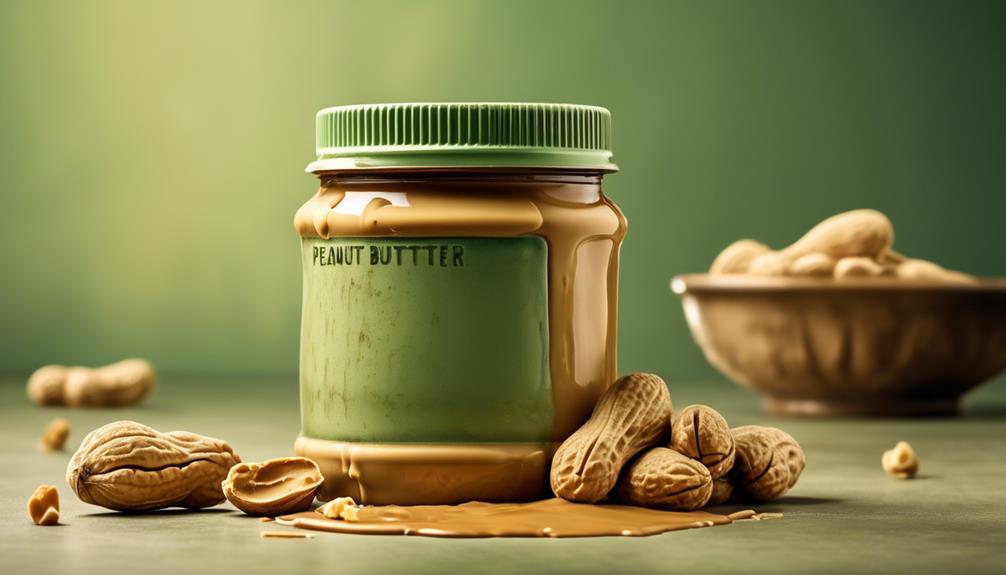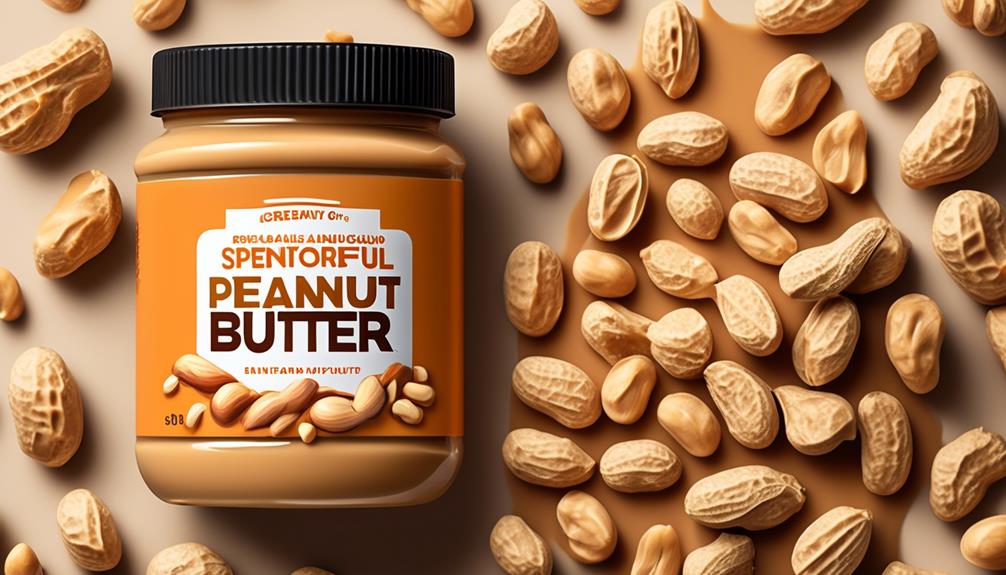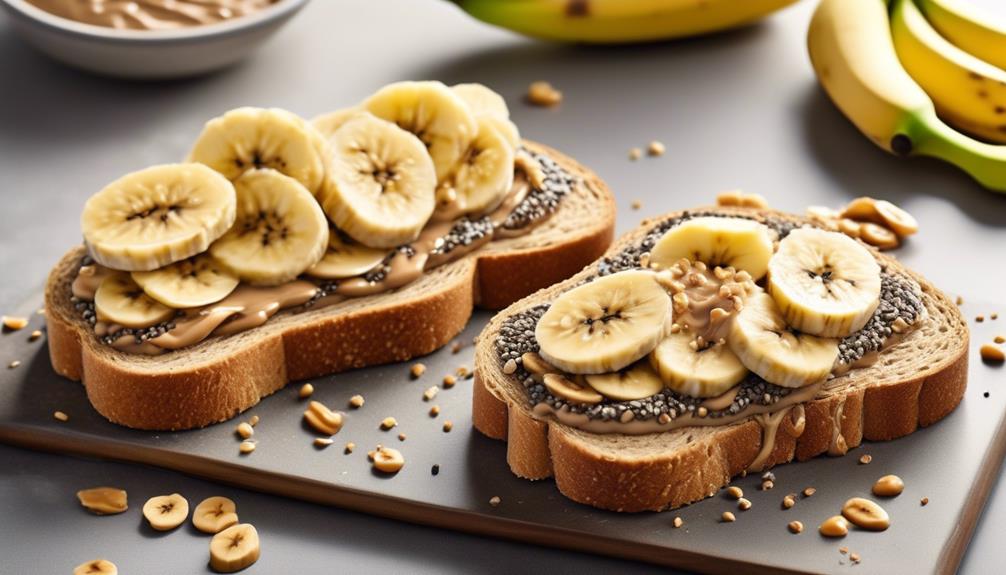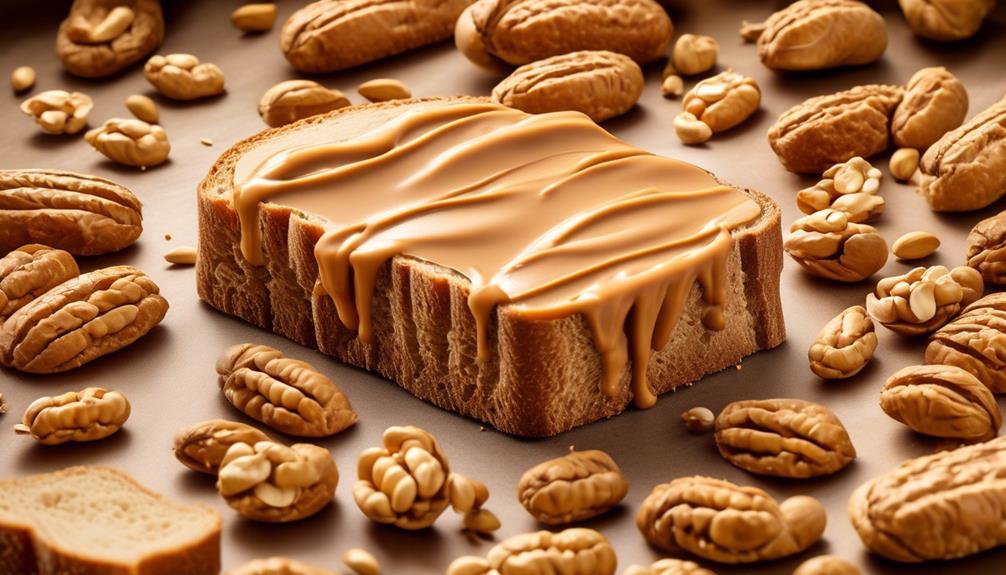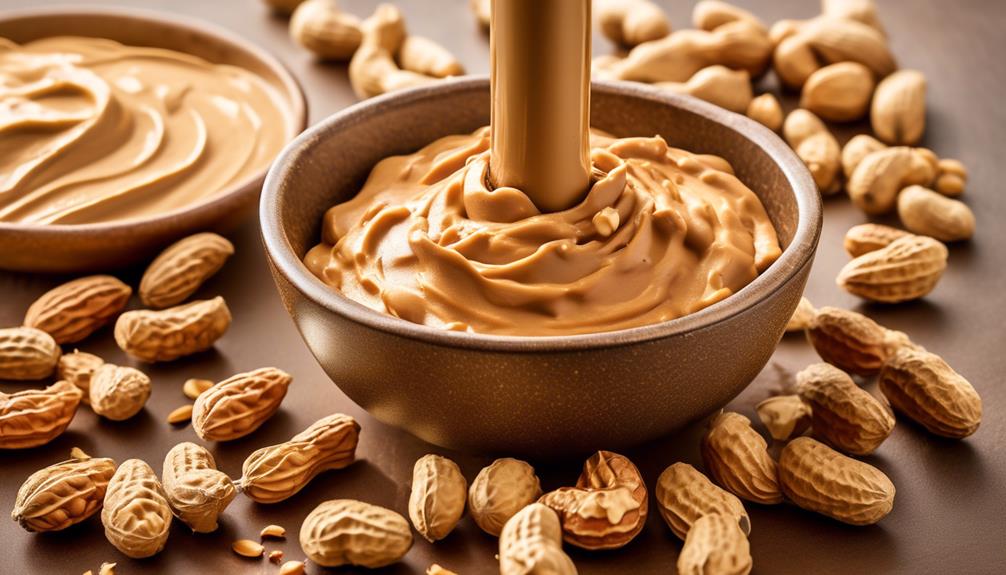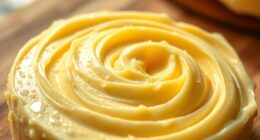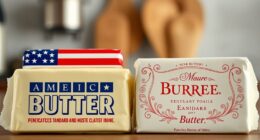Have you ever pondered what occurs when peanut butter reaches its expiration date?
Many of us have a jar tucked away in the pantry, forgotten until we reach for a snack.
But what happens when that familiar spread starts to change?
The answer might surprise you, as the consequences go beyond just the label date.
So, let's explore the potential outcomes of expired peanut butter and why it's essential to be mindful of its shelf life.
Key Takeaways
- Signs of expired peanut butter include a bitter or soapy smell, sharp or sour taste, darker color or dryness, and mold growth. Proper storage conditions are important to prevent spoilage.
- Expired peanut butter undergoes changes in texture and color, becoming grainy and dry, with a possible darkening in color. Oil separation also increases, especially in natural peanut butter, affecting spreadability and mouthfeel.
- Excessive oil separation and denser texture, along with darkening color, are common in expired peanut butter. Stirring the oil back in can help restore texture and color.
- Expired peanut butter loses flavor and aroma due to the high fat content going rancid. It may develop an unpleasant odor and become less enjoyable to consume. Rancid peanut butter can also pose potential health risks.
Signs of Expired Peanut Butter
When peanut butter expires, it exhibits noticeable signs of spoilage, indicating that it's no longer suitable for consumption. The high fat content in peanut butter makes it susceptible to rancidity, which is the primary cause of its spoilage.
Rancid peanut butter may emit a bitter, metallic, or soapy smell, and the taste can become sharp or sour. These changes in odor and taste are clear indicators of spoilage. Additionally, visual cues such as a darker color or dryness can also signify that the peanut butter has expired. Mold growth, especially in natural peanut butter, is another prominent sign of spoilage, making it crucial to check for any unusual discoloration or growth patterns.
Proper storage conditions play a significant role in extending the shelf life of peanut butter. Refrigeration and limiting air exposure can help maintain its quality. However, once the signs of spoilage appear, it's essential to discard the peanut butter to avoid potential health risks associated with bacterial growth.
Understanding these signs and being vigilant about the shelf life of peanut butter ensures that it's consumed at its best quality.
Change in Texture and Color

When peanut butter expires, the texture can become grainy and dry, and the color may darken.
Additionally, oil separation may increase, especially in natural peanut butter.
These changes in texture and color can be indicators of spoilage and should be taken into consideration when assessing the quality of peanut butter.
Texture Becomes Grainy
The grainy texture and altered color of expired peanut butter indicate a significant change in its composition and freshness, affecting its spreadability and overall mouthfeel.
When peanut butter expires, the texture becomes grainy and dry, with a change in color from the usual creamy consistency. The peanut oil may separate and form a layer on top, contributing to the grainy texture.
Additionally, the grainy texture may be accompanied by a less smooth mouthfeel when consuming the peanut butter. This change in texture and color indicates that the peanut butter has undergone a change in its composition and is no longer fresh.
The grainy texture could affect the spreadability and overall enjoyment of the peanut butter.
Color May Darken
After discussing the grainy texture and altered color of expired peanut butter, it becomes evident that the darkening color is a significant indicator of the change in texture and flavor.
When peanut butter expires, its color may darken due to the oxidation of the high fat content. This darkening signifies a decrease in the product's shelf life and a potential shift in its chemical composition.
The presence of oil separation in expired peanut butter also contributes to the darkened appearance, resulting in an uneven distribution of oil throughout the product.
Moreover, the darkened color is often accompanied by a rancid odor and flavor alteration, indicating that the peanut butter has gone bad.
Therefore, monitoring the color of peanut butter is crucial in determining its quality, as the darkening color serves as a visual cue for potential spoilage.
Oil Separation Increases
Excessive oil separation in natural peanut butter can lead to changes in both its texture and color, potentially impacting its overall quality. When the oil separation increases, the texture of the peanut solids may become denser, altering the spreadability and mouthfeel of the peanut butter.
Additionally, the oil rising to the top of the jar can cause the color of the peanut butter to darken, indicating a change in appearance. This change in texture and color can be off-putting to consumers who expect a smooth, consistent product.
However, it's important to note that oil separation doesn't necessarily mean the peanut butter has gone bad. Stirring the oil back into natural peanut butter can help restore its original texture and color, potentially extending its shelf life.
Loss of Flavor and Aroma

How does the expiration of peanut butter impact its flavor and aroma? When peanut butter expires, there is a significant loss of flavor and aroma due to its high fat content. The fats in peanut butter can go rancid, leading to a stale taste, dull appearance, and an unpleasant odor. This results in a reduction in overall palatability, making the peanut butter less enjoyable to consume.
| Impact of Peanut Butter Expiration |
|---|
| Loss of Flavor and Aroma |
| Stale Taste |
| Unpleasant Odor |
The expiration of peanut butter significantly affects its sensory qualities. As the fats break down, the rich nutty flavor diminishes, leading to a stale taste and an unpleasant odor. This decline in flavor and aroma can make the peanut butter less appealing to consumers.
Development of Rancid Smell

As peanut butter ages, the unsaturated fats within it can undergo oxidation, resulting in the development of a rancid smell. This process can also impact the taste and potentially pose health risks if consumed.
Understanding the factors that contribute to rancidity and its implications for both the quality and safety of peanut butter is crucial for ensuring its proper storage and consumption.
Rancidity and Taste
The development of rancid smell in peanut butter is primarily attributed to its high fat content, which can lead to an off-putting aroma and taste. When peanut butter goes bad, rancid smells such as bitter, metallic, or stale odors may develop, indicating spoilage. Changes in appearance, like a darker color or dryness, may also signal rancidity.
Rancid peanut butter may have a sharp or bitter taste, different from its usual flavor. Proper storage in a cool, dark place, and refrigeration for natural peanut butter, can help delay the development of rancidity. Understanding the signs of rancidity and changes in taste is crucial for determining the expiration of peanut butter and ensuring its quality.
Health Implications
Upon expiration, the high fat content in peanut butter can result in the development of a rancid smell, indicating potential health implications. When the natural oils in peanut butter, which contain high levels of fat, are exposed to oxygen over time, they can become rancid. This process is accelerated by factors such as light, heat, and moisture. Consuming rancid peanut butter may lead to gastrointestinal distress and could potentially cause foodborne illnesses. To prevent oil separation and prolong the shelf life of peanut butter, it is crucial to store it in a cool, dark place and consume it before the expiration date. Below is a table summarizing the potential health implications of consuming expired peanut butter:
| Health Implications of Expired Peanut Butter | ||
|---|---|---|
| Gastrointestinal Distress | Foodborne Illnesses | Potential Health Risks |
Potential Health Risks

Ingesting spoiled peanut butter can result in potential health risks, including exposure to harmful bacteria and the possibility of allergic reactions. Here's what you need to know:
- Food Poisoning and Digestive Issues: Consuming rancid peanut butter may lead to food poisoning, causing symptoms such as nausea, vomiting, diarrhea, and stomach cramps.
- Increased Exposure to Harmful Bacteria: Spoiled peanut butter can harbor harmful bacteria, such as Salmonella and E. coli, which can have detrimental effects on overall health.
- Allergic Reactions: Eating expired peanut butter can trigger allergic reactions in individuals with peanut allergies, potentially leading to severe symptoms like hives, swelling, and anaphylaxis.
- Health Complications: If peanut butter has gone bad, it's crucial to avoid consumption to prevent potential health complications. This is particularly important for natural peanut butter, which often has a shorter shelf life due to the absence of preservatives.
It's essential to be mindful of the shelf life of peanut butter and to discard any expired or spoiled products to safeguard your health.
Proper Storage Methods

Properly storing peanut butter is essential to maintain its freshness and prevent spoilage, ensuring its quality and safety for consumption.
Peanut butter should be stored in a cool, dark place like the pantry to preserve its flavor and texture.
Once opened, refrigerating peanut butter can extend its shelf life and prevent it from turning rancid. This is particularly important for natural peanut butters, which lack stabilizers and have a shorter shelf life.
The oil in natural peanut butter may separate over time, so it's important to stir it back in to maintain its consistency. Storing the jar upside-down can also help distribute the oil more evenly.
Additionally, refrigerating natural peanut butter can help to keep it fresh for a longer period.
Extending Shelf Life

To maximize the shelf life of peanut butter, it's advisable to store opened jars in the refrigerator. The cooler temperature helps slow down the oxidation process, reducing the risk of spoilage. Natural peanut butter, which lacks stabilizers, should always be refrigerated due to its shorter shelf life. Storing the jar upside-down can help distribute the oil more evenly, maintaining the desired consistency.
Unopened jars of peanut butter can last for months or even years, depending on the type. It's important to check the expiration date to ensure its freshness. Proper storage in a cool, dark place can help extend its shelf life.
Powdered peanut butter can last 10-12 months unopened. Storing it in a cool, dry, dark place can help maintain its quality and extend its shelf life.
Upcycling Empty Jars

After maximizing the shelf life of peanut butter through proper storage and use, it's time to consider the options for upcycling empty jars.
When it comes to upcycling, empty peanut butter jars can serve multiple functions. One option is to reuse them for making sauces or dressings. By adding hot water or broth and shaking it, the remaining peanut butter can be removed, making it ready for reuse.
Properly cleaned jars can also be recycled by filling them halfway with hot water and dish soap, shaking, and allowing them to dry before placing them in the recycling bin.
Additionally, these jars can be repurposed for storage of small items such as buttons, nails, or screws. They can also be utilized as candle holders or for DIY crafts like homemade candles or decorative jars.
Furthermore, empty peanut butter jars can be repurposed as containers for homemade beauty products such as DIY body scrubs or lotions.
Upcycling empty peanut butter jars not only offers a sustainable solution for disposal but also provides opportunities for creative and practical reuse.
Conclusion and Recommendations

We emphasize the importance of routinely checking for signs of spoilage in peanut butter, such as an off-smell, taste, or appearance, to ensure the consumption of a safe and fresh product.
Proper storage is crucial for maintaining the quality of peanut butter. Natural peanut butter, in particular, should be refrigerated after opening to extend its shelf life. It's essential to pay attention to the expiration date on the jar to gauge the freshness of the product. Additionally, consider refrigerating opened jars to prolong their shelf life.
When peanut butter has gone bad, it's vital to dispose of it properly. If using expired peanut butter for non-food purposes, ensure that it's used safely and appropriately, such as for traps or as a lubricant. Furthermore, consider exploring alternative nut or seed butters as substitutes.
Finally, it's commendable to donate unopened, non-expired peanut butter to food banks to reduce waste and support the community.
Frequently Asked Questions
Is It Okay to Eat Expired Peanut Butter?
It's not recommended to eat expired peanut butter. The high fat content makes it prone to spoilage, leading to off-putting smell, taste, or appearance.
Natural peanut butter without stabilizers has a shorter shelf life. Signs of spoilage include bitter or metallic odor, changes in appearance, and mold growth for natural peanut butter.
Proper storage, like refrigerating opened jars and storing natural peanut butter upside down, helps maintain its quality.
How Can You Tell if Peanut Butter Has Gone Bad?
We can tell if peanut butter has gone bad by examining its smell, taste, and appearance.
Signs of spoilage include:
- A bitter or metallic odor
- Stale smell
- Darker color
- Mold growth
- A sharp or bitter flavor
Proper storage in a cool, dark place or refrigeration for opened jars can help maintain quality and extend shelf life.
Natural peanut butter without stabilizers has a shorter shelf life and is more prone to spoilage than conventional peanut butter.
How Long Can You Use After Expiration Date?
We can use peanut butter for a short time after the expiration date. Inspect for signs of spoilage like off-putting odor, taste, or appearance. If it looks, smells, and tastes fine, it's likely safe to consume. But if there's any doubt, it's best to discard it.
To extend its usability, store it properly in the fridge or upside down to distribute the oil evenly.
Always prioritize safety when consuming expired foods.
Does Peanut Butter Go Bad in Heat?
Peanut butter can go bad in heat due to its high fat content, which can cause it to spoil and develop an off-putting smell, taste, or appearance. Proper storage is crucial to prevent spoilage, such as refrigerating natural peanut butter and storing conventional peanut butter in a cool, dark place.
Signs of spoiled peanut butter include changes in smell, appearance, and taste, as well as mold growth in natural peanut butter.
Conclusion
In conclusion, it's important to be aware of the signs of expired peanut butter, such as changes in texture, color, and aroma.
Proper storage methods, like keeping it in a cool, dark place or refrigerating opened jars, can help extend its shelf life.
However, if peanut butter does expire, is it worth the potential health risks?
It's crucial to monitor the quality of peanut butter and consider upcycling empty jars to avoid waste.
